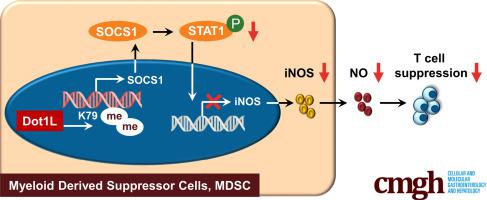Cellular and Molecular Gastroenterology and Hepatology ( IF 7.2 ) Pub Date : 2021-01-23 , DOI: 10.1016/j.jcmgh.2021.01.013 Wanlin Yang 1 , Hongshuang Yu 2 , Jiefang Huang 2 , Xiang Miao 2 , Qiwei Wang 3 , Yanan Wang 4 , Yiji Cheng 5 , Shan He 1 , Fang Zhao 1 , Lijun Meng 1 , Bei Wang 2 , Fengtao Qian 2 , Xiaohui Ren 2 , Min Jin 6 , Yuting Gu 5 , Yanyun Zhang 7 , Wei Cai 8

|
Background & Aims
Fulminant hepatitis (FH) is a clinical syndrome characterized by sudden and severe liver dysfunction. Dot1L, a histone methyltransferase, is implicated in various physiologic and pathologic processes, including transcription regulation and leukemia. However, the role of Dot1L in regulating inflammatory responses during FH remains elusive.
Methods
Propionibacterium acnes (P. acnes)-primed, lipopolysaccharides (LPS)-induced FH was established in C57BL/6 mice and was treated with the Dot1L inhibitor EPZ-5676. Myeloid derived suppressor cells (MDSCs) were depleted by anti-Gr-1 antibody to evaluate their therapeutic roles in Dot1L treatment of FH. Moreover, peripheral blood of patients suffered with FH and healthy controls was collected to determine the expression profile of Dot1L-SOCS1-iNOS axis in their MDSCs.
Results
Here we identified that EPZ-5676, pharmacological inhibitor of Dot1L, attenuated the liver injury of mice subjected to FH. Dot1L inhibition led to decreased T helper 1 cell response and expansion of regulatory T cells (Tregs) during FH. Interestingly, Dot1L inhibition didn’t directly target T cells, but dramatically enhanced the immunosuppressive function of MDSCs. Mechanistically, Dot1L inhibition epigenetically suppressed SOCS1 expression, thus inducing inducible nitric oxide synthase (iNOS) expression in a STAT1-dependent manner. Moreover, in human samples, the levels of Dot1L and SOCS1 expression were upregulated in MDSCs, accompanied by decreased expression of iNOS in patients with FH, compared with healthy controls.
Conclusions
Altogether, our findings established Dot1L as a critical regulator of MDSC immunosuppressive function for the first time, and highlighted the therapeutic potential of Dot1L inhibitor for FH treatment.
中文翻译:

抑制 Dot1L 通过髓源性抑制细胞减轻暴发性肝炎
背景与目标
暴发性肝炎(FH)是一种以突发性和严重肝功能障碍为特征的临床综合征。Dot1L 是一种组蛋白甲基转移酶,涉及各种生理和病理过程,包括转录调节和白血病。然而,Dot1L 在调节 FH 期间炎症反应中的作用仍然难以捉摸。
方法
在 C57BL/6 小鼠中建立了由痤疮丙酸杆菌( P.acnes ) 引发的脂多糖 (LPS) 诱导的 FH,并用 Dot1L 抑制剂 EPZ-5676 治疗。骨髓来源的抑制细胞 (MDSCs) 被抗 Gr-1 抗体耗尽,以评估它们在 Dot1L 治疗 FH 中的治疗作用。此外,收集患有 FH 的患者和健康对照的外周血,以确定其 MDSC 中 Dot1L-SOCS1-iNOS 轴的表达谱。
结果
在这里,我们发现 EPZ-5676,Dot1L 的药理学抑制剂,减轻了 FH 小鼠的肝损伤。Dot1L 抑制导致 FH 期间 T 辅助细胞 1 细胞反应降低和调节性 T 细胞 (Tregs) 扩增。有趣的是,Dot1L 抑制并不直接针对 T 细胞,而是显着增强了 MDSC 的免疫抑制功能。机制上,Dot1L 抑制表观遗传抑制 SOCS1 表达,从而以 STAT1 依赖性方式诱导诱导型一氧化氮合酶 (iNOS) 表达。此外,在人类样本中,与健康对照组相比,MDSCs 中 Dot1L 和 SOCS1 表达水平上调,同时伴有 iNOS 在 FH 患者中的表达降低。
结论
总之,我们的研究结果首次确立了 Dot1L 作为 MDSC 免疫抑制功能的关键调节因子,并强调了 Dot1L 抑制剂在 FH 治疗中的治疗潜力。


























 京公网安备 11010802027423号
京公网安备 11010802027423号